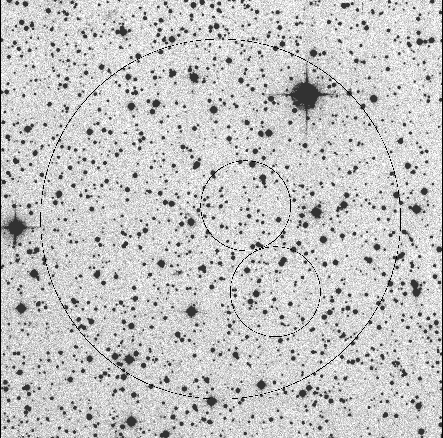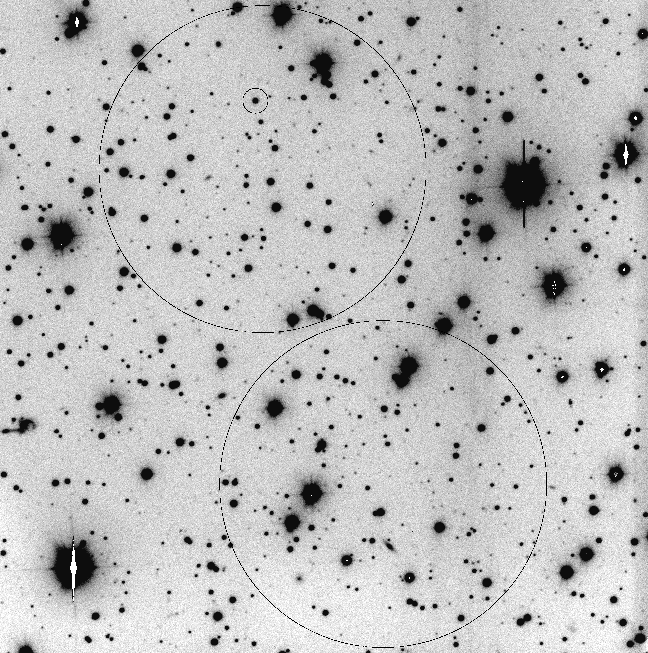|
|
GRB 991014: POSS-II Plate
(J2000) 06 51 06.5, +11 35 38.2
WFC 6' radius error circle
(NFI 1.5' radius error circles from GCN #427)
 |
| GCN Circular #423: GRB 991014, Optical Observations |
J. Thorstensen (Dartmouth), R. Uglesich, J. Halpern, N. Mirabal (Columbia U.), E. Costa, M. Feroci, L. Piro (IAS/CNR, Rome) report on behalf of the MDM Observatory GRB follow-up team and the BeppoSAX team: "We imaged the field of GRB 991014 in the R band starting on Oct. 15.38 UT, 11.2 hours after the burst, using the MDM Observatory's 1.3m and 2.4m telescopes. The entire 6' radius error circle from the BeppoSAX WFC (Gandolfi, GCN #417) was covered at the 1.3m, and the entire 2' radius NFI error circle of a possible X-ray afterglow (BeppoSAX MAIL n. 99/28) was covered at the 2.4m. There was no new object brighter than the digitized POSS-II limit in the WFC error circle. We reobserved the NFI error circle on the 2.4m on Oct. 16.42 UT. Seeing was 1.1-1.2 arcseconds on both nights, and the 5 sigma limiting magnitude was R = 23.1. No variable object was detected in the NFI error circle. This magnitude limit is referenced to a USNO star at position (J2000) RA 06:51:03.17, Dec +11:36:42.6 which has R = 17.61 +/- 0.02 according to the recent calibration of Henden et al. (GCN #422). This message may be cited." |
GRB 991014: MDM 2.4m R-band CCD Image
1999 Oct. 16.42 - 30 minutes exposure
Circled calibration star has R = 17.61 (GCN #422)
 |
| GCN Circular #428: GRB 991014, Optical Observations |
R. Uglesich, J. Halpern (Columbia U.), & J. Thorstensen (Dartmouth) report: "In addition to the MDM observations reported in GCN #423, we reobserved the entire 6' radius error circle of the BeppoSAX WFC (Gandolfi, GCN #417) with the 1.3m because it is not known if either of the reported NFI X-ray sources (in 't Zand et al. GCN #427) is associated with the GRB. The 1.3m observations were centered on Oct. 15.45 UT and Oct. 16.48 UT, and reach a 5-sigma limiting magnitude of R = 22.6 on the first night, and R = 22.8 on the second night. We used a non-standard, broad R filter which nevertheless calibrates very well with Landolt (1992) standards that we obtained. We find R = 17.64 for the star mentioned in GCN #423, which is consistent with the USNO calibration (R = 17.61 +/- 0.02). Although we have not yet carried out a detailed photometric analysis of the entire WFC circle, careful visual inspection reveals no variable object to a limit of approximately R > 22.6 at 13 hours after the burst. The images from the MDM 2.4 reported in GCN #423 cover the error circles of both of the NFI sources, and our previously reported limit of R > 23.1 at 11.2 hours still applies. We also note that Galactic extinction in this direction is estimated to be E(B-V) = 0.202 from IRAS dust maps (Schlegel et al. 1998), so A_R is a modest 0.54 magnitudes. A CCD image of the field of the NFI sources is posted at http://www.astro.bio2.edu/grb/ This message may be cited." |
